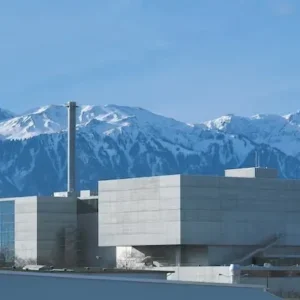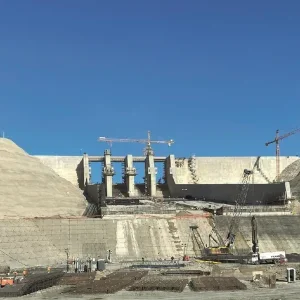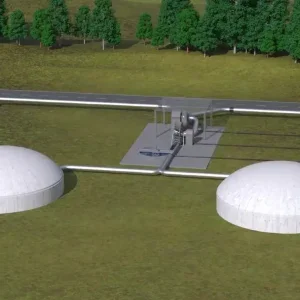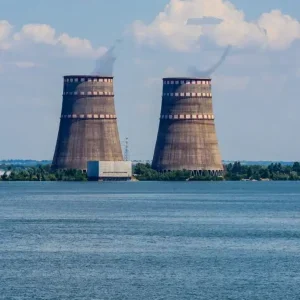
Fossil fuel energy resources are limited and environmental regulations such as the Kyoto protocol have led to the increased use of renewable energy resources such as wind, solar, biomass and geothermal energy. In Germany, for example, the installed power in wind farms in 2005 reached 19GW. The declared target is to integrate 20% of installed renewable power by the end of 2020. Other countries are following with similar developments. Due to the stochastic nature of wind energy, it is difficult to plan and not possible to control the production of wind parks. In order to guarantee the stability of a power network, production has to be identical to the consumption. One way to control the power balance in a network is to store the surplus electrical energy and, to date, pumped storage power stations present the most efficient way of storing large amounts of electrical energy at acceptable costs.
Conventional pumped storage
In conventional pumped storage power stations, a salient pole synchronous motor-generator is coupled either to a separate pump and turbine or to a reversible pump turbine. The arrangement can be horizontal or vertical. Because the rotational direction of a separate pump and turbine arrangement is the same in both operation modes, this setup allows for a more rapid change from turbine to motor operation mode or vice versa. It is however more complex and leads to longer shaft arrangements resulting in higher costs, especially if the power station is located in a cavern.
In contrast, solutions involving a reversible Francis turbine are more compact. Figure 1 shows an example of a salient pole motor-generator coupled to a reversible Francis turbine. In this case, the hydraulic machine acts as a pump in one rotational direction and as a turbine in the other rotational direction. Consequently, the unit has to be stopped and accelerated for a change from turbine to pump mode or vice versa. Depending on the hydraulic head, reversible Francis turbines can be designed as single or double-stage arrangements. A technical highlight of the double-stage pump turbine is that the power can be regulated using synchronized guide vanes in both stages [6].
Variable speed pumped storage
In variable speed power stations static frequency converters are used to vary the speed of the electrical machine. For installations with a power lower than approximately 50MW, this can be realized using conventional synchronous generators linked to the grid by a static frequency converter. For larger units, this solution would be more difficult to justify economically. For units larger than 50MW, double fed induction machines with a static frequency converter feeding the rotor are the preferred solution. See [2] for a more in depth discussion of the two solutions.
The basic principle of the double fed induction machine consists in the creation of a rotating field on the rotor allowing the machine to be operated within a certain speed range around the synchronous speed. The relative difference in speed is called slip. Usually, the slip range is within +- 10%. In first realizations of variable speed pumped storage projects, Cyclo converters were used to create the rotating field on the rotor. Cyclo converters are direct converters and, consequently, absorb reactive power. This power needs to be compensated by condensers or provided by the generator. Furthermore, the frequency range of such converters is limited. They cannot be used to start the unit in pump mode, which means an additional static frequency converter needs to be used to start the unit. Cyclo converters using Thyristors are a robust technology proven for many years. More recently, improvements in the power ratings of IGBTs and IGCTs allow for the construction of large voltage source inverters. This kind of static frequency converter is used in other applications like steel lamination production and can now be used instead of Cyclo converters. These converters do not absorb reactive power. Furthermore, they can be used to start the motor in pump mode. For this purpose the stator is short-circuited and a rotating field of increasing frequency is injected into the rotor.
Advantages of variable speed
The main advantage of variable speed is that the power absorbed in pumping mode can be varied over a certain range. Figure 2 shows a typical operation range in pump mode. It can be seen that depending on the given head, the power absorbed from the network can be varied by approximately 30%. This gives the operator of the power station the possibility to contribute to the grid frequency regulation even in pump mode. In conventional pumped storage plants frequency regulation is only possible in turbine mode, which is economically interesting if the power demand is high. If power demand and prices are low, however, it is preferable to deliver the same service (frequency regulation) in pump mode to the grid operator while filling the upper reservoir.
Since reversible Francis turbines are first designed as pumps, the resulting operation area in turbine mode on the hill chart does not coincide with the top of the hill. Consequently, the turbine cannot be operated at the best possible efficiency. Modifying the speed of the turbine allows for a shifting of the operation area closer to the top of the hill chart resulting in higher efficiencies, especially in partial load operation.
Large head variations make it difficult to find an optimal design of the pump turbine for both operation modes. Using two-speed motor-generators solved this difficulty in the past. These are synchronous salient pole generators on which the number of active poles on the rotor can be changed between two numbers. Furthermore the stator is equipped with two separate windings, each corresponding to one specific number of poles. See reference [1] for more information about this technology. This solution is limited to a restricted set of speeds and consequently cannot be used in all situations. Furthermore the electrical machine is more complex and bigger. Taking this into account, variable speed technology is more advantageous in today’s market.
Variable speed systems can respond more dynamically to changes in power set point values. In conventional setups, power variation can be achieved only by changing the opening of the guide vanes. This can only be done according the defined opening and closing laws in order to avoid over or under pressures in the penstock and the draft tube. Using variable speed units, the same adaptations are done on the turbine side. During the slow reaction time of the hydraulic system however, the power of the electrical machine can adapt to the new set point value respecting electrical time constants that are at least one order of magnitude lower. The difference in power delivered to the grid (according to the new set point) and the power delivered by the turbine results in a speed change that can be corrected later on. In other words, the difference in power is temporarily stored or provided by the kinetic energy of the rotor. For more details on this flywheel effect refer to [3] and [7].
Finally, it is also possible to use the fact that the speed of the unit can be changed in order to avoid critical zones in pump operation. This results in a reduction of the required minimum submergence of the pump turbine. Depending on the powerhouse setup, this can have a positive effect on civil engineering costs. It is important to note that this advantage cannot be exploited fully without negative impact on the possible power range, and the potential efficiency improvement.
This variety of advantages and options show that it is more difficult to specify and define a variable-speed power station compared to a classical plant. Speed range, power range, starting time and submergence are only some of the parameters that need to be optimized. An iterative process between the final customer and the OEMs, before the finalization of the specifications, allows for more optimal solutions.
Design of double fed induction motor-generator
The stator of a double fed induction machine is similar to the stators of conventional hydro generators. Double fed induction machines are larger in size, have a higher moment of inertia and smaller air gaps compared to salient pole machines of the same speed and power. The rotor design is quite different. Three main parts are completely different compared to synchronous machines and are discussed here.
Slip rings
To feed the rotor with the three phase current system, at least one slip ring per phase and usually one slip ring for the star point are needed. The slip rings need to be designed for currents up to 8 kA depending on power and design of the machine. Voltages can go up to 8 kV. In normal operation, the frequency of the currents is low. At synchronous speed, the currents become constant. During start up, the frequency increases gradually and is equal to the grid frequency at the end of the start up process. The brush system and the slip rings need to be designed for these requirements. For a regular consumption of the carbon brushes, air temperature and humidity need to be controlled. Furthermore, it is advisable to separate the slip ring housing from the cooling airflow of the motor-generator to avoid contamination by carbon dust. Special attention has to be paid to an even distribution of the currents on the different carbon brushes.
Winding overhang retaining system
The rotor winding overhang has to be supported to avoid deformation and damage if the machine speed comes close to runaway speed during load rejection. Three basic concepts can be distinguished.
The first concept uses a steel retaining cap similar to the design used in Turbo generators (cylindrical rotor generators). The caps can be shrunken and are dismountable. The steel cap needs to withstand high mechanical forces and is made of forged non magnetic steel. For large diameter machines, the manufacturing of such caps can be difficult. Furthermore the ring needs to be built in one piece. This can be incompatible with the transport limitations for underground stations.
For the second concept, the whole overhang is bandaged either by a steel or synthetic wire or a synthetic foil. The application of the wire or the foil needs special tools and a lot of experience. Dismantling of the system without destruction of the bandage is generally not possible. Special attention needs to be paid to the cooling of the winding overhang for the first two solutions, because the cooling airflow cannot pass through the winding overhang in radial direction.
The third concept consists in a set of retaining bolts (or u-shaped rods) that fix the winding overhang to an auxiliary rim mounted on the rotor rim. Figure 3 shows an extract of a patent describing this kind of solution [8]. Cooling air can directly pass through the winding overhang in radial direction. Furthermore it is possible to dismantle individual bars if required. The main disadvantage of this solution consists in the large number of bolts used in the machine.
The bolts need to be designed for frequent starts and stops and a defined number of excursions of the machine to runaway speed. Due to the high number of bolts, detailed statistical analyses based on mechanical cycling tests need to be carried out for the validation of the used materials. Furthermore a strict quality process defining individual checking of each bolt is required.
Rotor rim
The third part worth mentioning is the rotor rim, also called rotor yoke. Similar to the winding overhang retaining system, the rotor rim is also exposed to mechanical cycling. Finite element, and analytical calculations can be used to define the required mechanical properties. Since the rotor rim consists of a highly inhomogeneous stack of varnished steel laminations, it is advisable to cross check the calculation by practical tests.
In contrast to the rotor rim of a salient pole machine, the rim of an induction machine is carrying an alternating magnetic field. To reduce the iron losses created by eddy currents and hysteresis effect materials with low loss coefficients can be used. See reference [9] for more details on iron losses. Generally materials with high yield strengths have relatively high magnetic loss coefficients. Especially for machines with higher speed ranges, the corresponding losses can become important and need to be computed carefully.
Variable speed power stations in Europei
Nant de Dranceii power station is being developed in the south west of Switzerland, close to the French border, and is expected to be commissioned in 2015. alstom will supply four 157MW vertical Francis reversible turbines, four 170 MVA vertical asynchronous motor/generator units and further key equipment to the new plant, as well as handling complete site delivery, erection, supervision and commissioning. Rotational speed is 428.6 rpm with a speed range of ± 7%, with the rotor fed by a voltage source inverter. The project’s upper reservoir holds a volume of 11.4Mm3, and the head varies between 250 and 390m.
Also planned for commissioning in 2015 is the Linthal 2015iii project in northeast Switzerland. Alstom will provide four 250MW variable speed pump turbine and motor generator units. Scope includes: design, engineering, manufacturing, installation, testing, commissioning and training services. Rotational speed is 500rpm with a speed range of ± 6%, and the rotor is again fed by a voltage source inverter. The upper reservoir holds a volume of 25Mm3, and the head varies between 560 and 724m.
Dr. Alexander Schwery holds a Phd degree in Electrical Engineering from the Swiss Federal Institute of Technology (EPFL 1999) in Lausanne. He joined Alstom (Switzerland) Ltd. (former ABB Kraftwerke AG) in 1999 were his main field of application are the use and development of different simulation and calculation tools for salient pole generators. Currently he is the head of the Electrical and Ventilation group and deputy to the head of the Generator Technology Centre.
Thomas Kunz joined Alstom in 1991 as a electrical designer for Hydro Generators. He held various positions in the Hydro Generator Engineering department in Switzerland. Since Thomas was appointed to R&D / Technology Director in 2002, he has the overall responsibility for the Electrical R&D and leads product development programs in alstom-hydro.
This article is based on a paper originally presented at the Waterpower XVI conference held in July 2009 in Spokane, Washington. The conference technical papers are available on CD from PennWell’s Hydro Group. www.waterpowerconference.com






